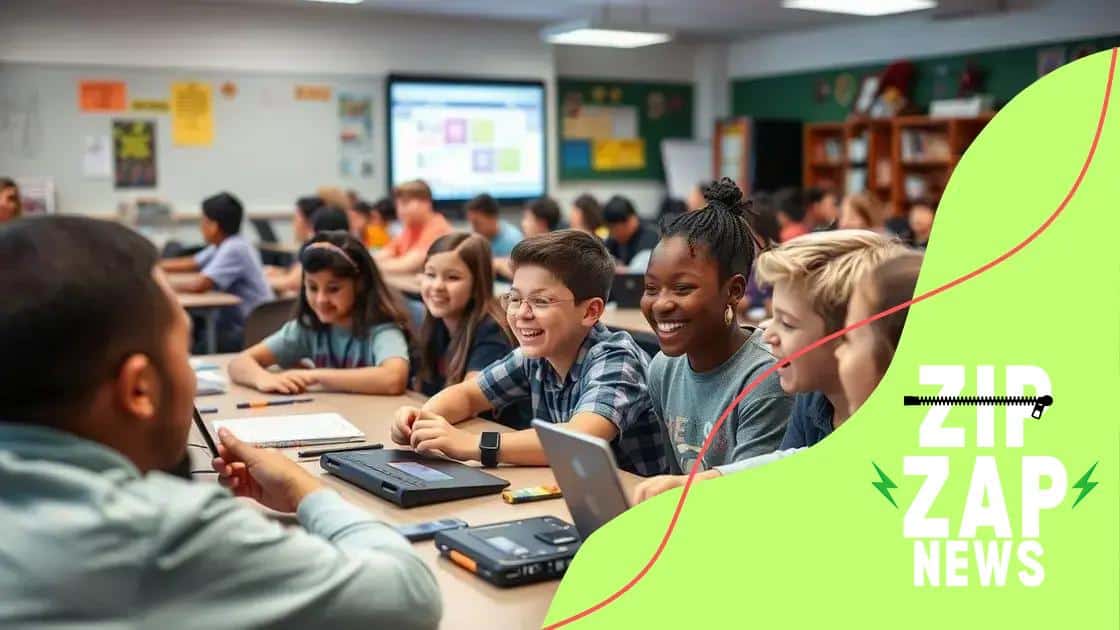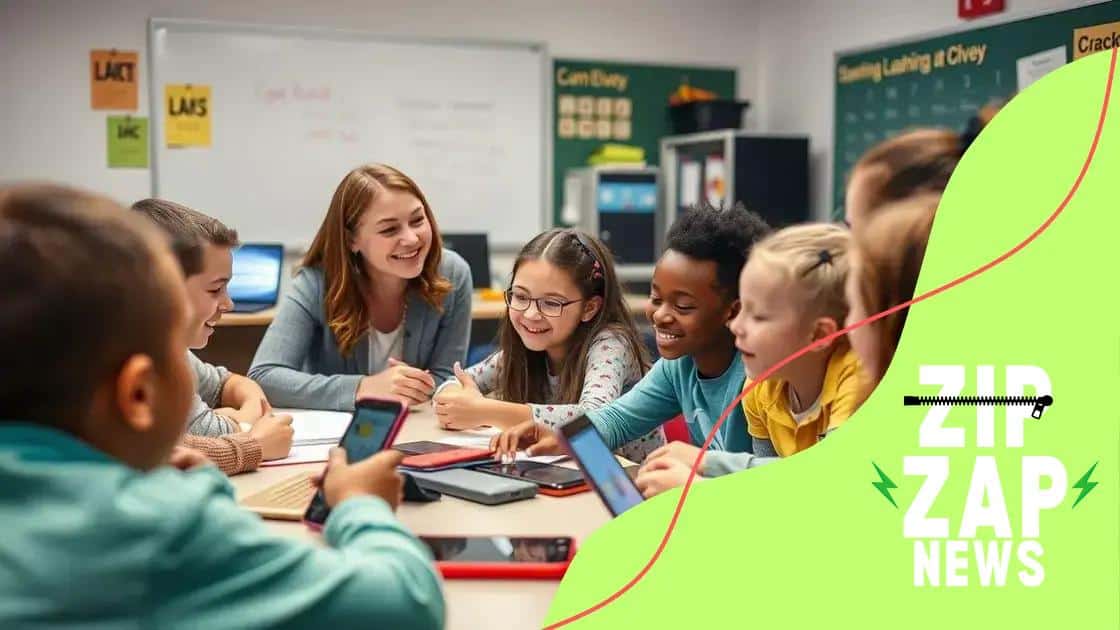Gamified educational tools for engagement: ignite curiosity

Gamified educational tools enhance student engagement and learning by integrating game mechanics into lessons, making education interactive and enjoyable through platforms like Kahoot! and Classcraft.
Gamified educational tools for engagement are changing the landscape of learning. Ever wondered how games can make education more fun? Let’s dive into this exciting world!
Understanding gamified educational tools
Understanding gamified educational tools is essential for educators looking to enhance their teaching methods. These tools integrate gaming elements into the learning process, making education more interactive and enjoyable.
Gamification simplifies complex subjects by adding elements students love. It can motivate learners to engage more deeply and foster a sense of achievement. Imagine a classroom where students are eager to participate because learning feels like playing a game!
What are gamified educational tools?
Gamified tools include various applications and platforms that incorporate game mechanics in educational settings. Here are some common features:
- Points and Rewards: Students earn points for completing assignments or participating in class.
- Leaderboards: Friendly competition is encouraged by showcasing top performers.
- Challenges: Students face missions or challenges that relate to their curriculum.
- Instant Feedback: Quick feedback helps students understand their progress and areas for improvement.
These features make learning more dynamic and enhance student engagement. By turning lessons into games, educators can capture students’ attention and promote active learning.
Examples of gamified tools
Several tools are available that embody gamification principles. For instance, platforms like Kahoot! and Classcraft allow educators to create engaging quizzes and challenges that motivate students. They can also track individual progress, making it easier to personalize learning experiences.
Moreover, gamified educational tools can be used in various subjects, from math to history, and can accommodate different learning styles. This versatility is one of the key reasons for their growing popularity.
Using these tools in the classroom can lead to more cooperative learning environments. Students often work in teams, which helps build social skills and fosters collaboration.
Why do these tools matter?
Understanding the impact of gamified educational tools is crucial. They not only help with engagement but also aid in retention. When students enjoy learning and feel motivated, they retain information longer. This leads to better academic performance overall.
In conclusion, integrating gamified educational tools into education opens up new possibilities for students and teachers alike. As we continue to explore innovative teaching methods, these tools will undoubtedly play a vital role in the future of education.
Benefits of gamified learning methods
The benefits of gamified learning methods are significant and can transform the educational experience. By combining game design elements with traditional learning, these methods help to create an engaging and effective learning environment.
One of the primary advantages of gamification is that it motivates students. When learning is presented in a game format, students are more likely to participate actively. They often feel excited about completing quests or achieving high scores, which leads to a deeper commitment to their studies.
Enhances engagement
Engagement is crucial in education. Gamified methods foster a sense of community among learners. Students often collaborate to solve challenges or compete in teams. This camaraderie can make the learning process more enjoyable for everyone involved. Not only do students learn from their peers, but they also develop social skills along the way.
- Increased Motivation: Students are driven to learn when they see progress through rewards.
- Immediate Feedback: Gamification provides instant feedback, helping students adjust quickly.
- Enhanced Retention: Learning through games often leads to better retention of information.
- Individualized Learning: Gamified tools can adapt to a student’s learning pace, offering a personalized experience.
Moreover, gamified learning methods often include storytelling elements that make lessons more relatable. When students understand the context of what they are learning, they are more likely to connect with the material on a personal level.
Supports skill development
These methods also encourage critical thinking and problem-solving skills. Many games require players to think strategically or make quick decisions. This kind of thinking is essential in academic settings and in real life. As students tackle challenges in a gamified environment, they learn to approach problems with a solution-oriented mindset.
Using gamified learning methods goes beyond just making lessons fun. It creates a holistic educational experience where students gain knowledge and develop essential life skills. As we continue to embrace technology in education, the benefits of gamification will only become more evident.
How to implement gamified tools effectively

Implementing gamified tools effectively requires thoughtful planning and execution. It’s essential to create an environment where students can thrive. To start, educators should identify the learning goals they want to achieve. Knowing what you want to accomplish will guide the selection of appropriate tools.
Incorporating gamified tools should feel seamless. This means integrating them into the existing curriculum without overwhelming students. Teachers can begin with small activities, gradually increasing complexity to keep things exciting. By doing this, educators can assess what works best for their students without disrupting their flow of learning.
Choosing the right tools
Not all gamified tools are created equal. It’s vital to choose ones that enhance the learning experience. Consider the following factors when selecting gamified tools:
- User-friendly interface: Ensure that the tool is easy for students to navigate.
- Alignment with curriculum: The tool should support the subjects being taught.
- Feedback mechanisms: Look for tools that provide instant feedback to motivate students.
- Customization options: Choose tools that allow customization to suit different learning styles.
After choosing the right gamified tools, the next step is to set clear rules and expectations. When students understand how to earn points or achieve goals, they are more likely to engage. Also, incorporating competitions and challenges can spark motivation among students, encouraging them to participate actively.
Monitoring progress
Regularly monitoring students’ progress is essential. This helps educators see how well the gamified tools are working. Teachers should take note of individual student performance and adjust their approach as needed. If certain activities are not engaging students, it may be time to switch things up.
Moreover, encouraging students to reflect on their learning experience can provide valuable insights. Teachers can ask questions like, “What did you enjoy the most?” or “How did this activity help you learn?” This feedback can guide future implementations of gamified tools.
As educators continue to use gamified tools, they should celebrate milestones and achievements. Recognizing students’ efforts keeps morale high and reinforces the positive aspects of their learning journey.
Exploring popular gamified platforms
Exploring popular gamified platforms can reveal valuable tools that enhance learning experiences. These platforms incorporate game mechanics to engage students, making learning more enjoyable. Let’s take a look at a few well-known options that have made an impact in classrooms everywhere.
One of the top platforms is Kahoot!. This tool allows teachers to create quizzes that students can play in real-time. Students use their devices to answer questions, and they earn points for correct answers. The competitive aspect keeps everyone engaged, and it’s great for review sessions.
Classcraft
Another popular choice is Classcraft. This platform turns the classroom into a game where students can create avatars and earn rewards for positive behavior and academic success. Teachers can customize their lessons and track student progress through a gaming interface. Classcraft fosters collaboration, as students often team up to complete quests.
- Engagement: Students remain motivated by their roles in the game.
- Behavioral management: Positive actions lead to rewards.
- Social skills: Teamwork is encouraged throughout the game.
Another platform worth mentioning is Quizizz, which combines quiz taking with a game-like feel. Like Kahoot!, students can compete against each other or work at their own pace. The feedback is instant, helping them learn from their mistakes. This platform is particularly beneficial because it allows for both individual and group learning.
Motivating with Duolingo
Kicking off learning with language games brings in a new dimension. Duolingo is an excellent example of a gamified language-learning platform. Students progress through levels as they complete lessons, earning points and achievements along the way. The app’s fun graphics and engaging exercises make language learning feel less like homework and more like a hobby.
Many of these platforms offer free versions, making them accessible to schools with tight budgets. This accessibility allows educators to integrate gamified elements into their courses without a significant financial burden. Using popular gamified platforms ensures that students remain engaged and eager to participate in their learning.
Measuring engagement and success in education
Measuring engagement and success in education involves various strategies that teachers can use to assess how well students participate in learning activities. Understanding these metrics is crucial for enhancing the overall educational experience.
One way to gauge engagement is through direct observation. Teachers can look for signs of enthusiasm during lessons. Are the students actively participating? Do they raise their hands to answer questions? This kind of observation provides immediate feedback on how engaged students are in the learning process.
Using analytics tools
Another effective method for measuring engagement includes using analytics tools available in many gamified platforms. These tools can track student interactions and performance metrics over time. They can show which activities generate the most interest, helping teachers adjust their strategies accordingly.
- Completion rates: Monitoring how often students complete tasks can indicate their level of engagement.
- Performance scores: High scores may suggest that students are invested and understanding the material.
- Activity participation: Tracking which students frequently participate helps identify those who may need additional support.
Surveys and feedback forms also provide valuable information. Asking students their thoughts on activities can reveal what they enjoy and what they might find challenging. This feedback allows educators to tailor future lessons to better meet student needs. Engaging students by considering their input is a great way to promote a positive learning environment.
Assessing overall success
To measure overall success, it’s important to set clear goals. Educators should define what success looks like for their students. It could relate to academic performance, skill acquisition, or emotional growth. Regular assessments through tests, projects, and presentations can serve as benchmarks to measure progress.
Another way to gauge success is by observing the long-term impact of gamified learning. Are students retaining information better? Are they more likely to pursue higher education? These questions can help educators evaluate the effectiveness of their teaching methods and gamified tools.
Ultimately, using various approaches to measure engagement and success will create a comprehensive understanding of how well students are learning. By incorporating both quantitative and qualitative data, teachers can build effective strategies that foster a better educational experience.
FAQ – Frequently Asked Questions About Gamified Educational Tools
What are gamified educational tools?
Gamified educational tools are resources that incorporate game elements into learning to engage students and make education more enjoyable.
How do gamified tools increase student engagement?
These tools motivate students by turning learning activities into games, which makes participation more fun and rewarding.
Can gamified learning be personalized?
Yes, many gamified platforms allow customization to meet individual student needs and learning styles.
What metrics can be used to measure success in gamified education?
Metrics such as completion rates, performance scores, and student feedback can help assess the effectiveness of gamified learning methods.





